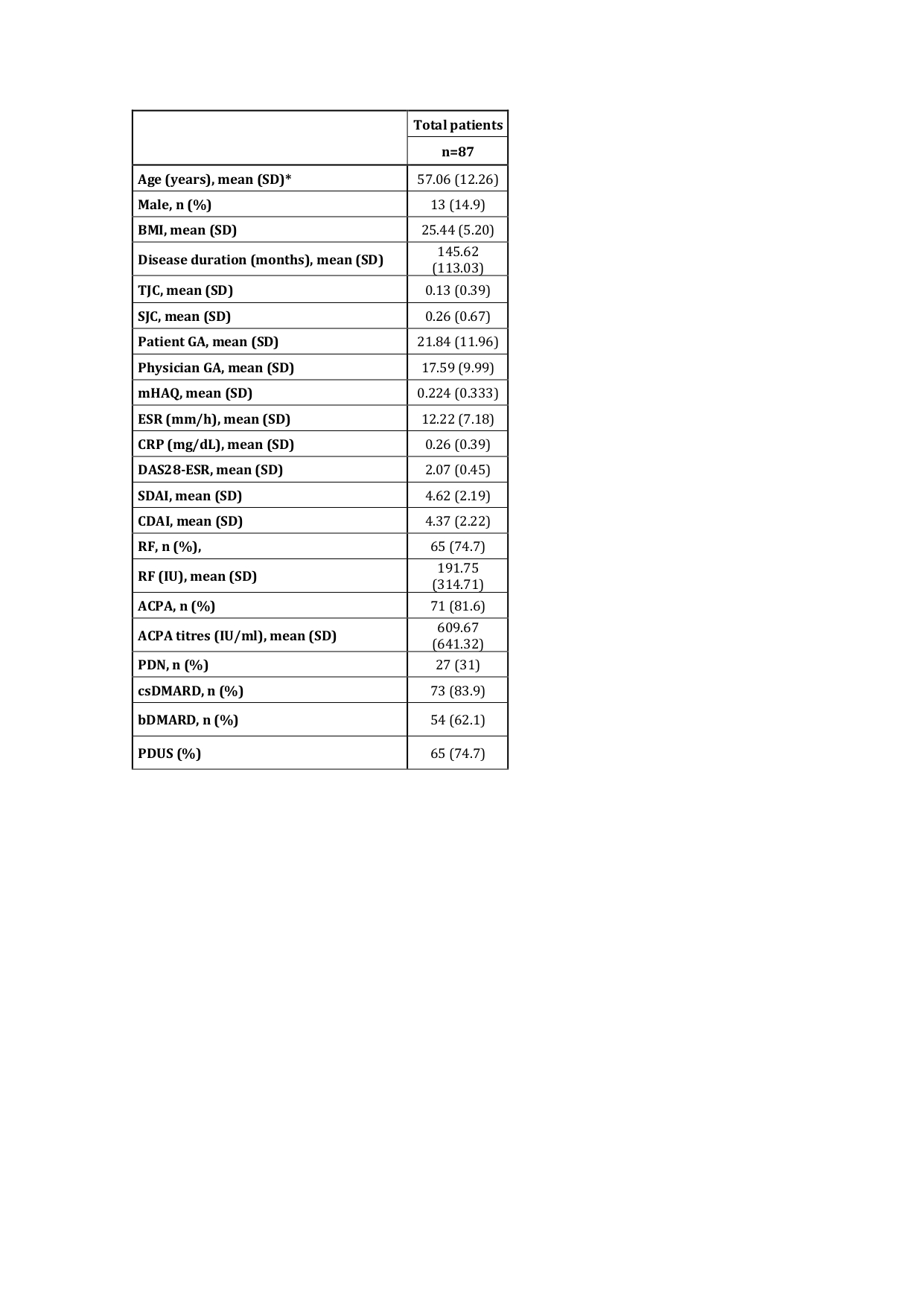Session Information
Date: Monday, November 9, 2020
Title: RA – Diagnosis, Manifestations, & Outcomes Poster IV: Lifespan of a Disease
Session Type: Poster Session D
Session Time: 9:00AM-11:00AM
Background/Purpose: To compare long-term clinical and radiographic outcomes among five sets of remission criteria [four clinical and one Ultrasound (US)-based] in a cohort of RA patients in a clinical care setting.
Methods: RA patients in remission (DAS28-ESR < 2.6) were selected. Hand US assessments were performed, and serum levels of inflammation/angiogenesis biomarkers were determined at baseline. Changes in baseline treatment and radiographic progression, defined as the variation in the modified Sharp van der Heijde score (mSHS) at 5 years, were analyzed.
To define remission, five different concepts were used, as follows: DAS28-ESR< 2.6, SDAI< 3.3, CDAI< 2.8, Boolean criteria and score Power Doppler (PD)=0.
Results: Eighty-seven patients with DAS28-ESR< 2.6 were included (table 1). One third fulfilled SDAI (33.3%), CDAI (31%) and Boolean (35.6%) remission criteria and 25.3% had no PD signal in the US evaluation.
26 patients (29.9%) changed the therapy, ranging from 13.6% (PD remission) to 33.3% (CDAI remission) (p=0.11) (Table 2).
Serum levels of ANG (p=0.015) and TNFa (p=0.025) were significantly lower in patients with Boolean remission, whereas IL-18 levels were significantly lower in those with PD remission (p=0.049). Patients without PD in the US assessment had significantly lower mSHS erosion progression (p=0.014) at 5 years (Figure).
Conclusion: Patients with established RA in DAS28-ESR remission had comparable clinical and radiographic outcomes than SDAI, CDAI and Boolean definitions in a clinical care setting. US remission remained as the closest to structural damage abrogation.
 Table 1. Baseline characteristics. *Data are expressed as mean (standard deviation) or as percentage; ACPA: anti-cyclic citrullinated peptide/protein antibody; bDMARD: biological Disease-Modifying antirheumatic drug; BMI: Body Mass Index; CDAI: Clinical Disease Activity Index; CRP: C-Reactive Protein; csDMARD: conventional synthetic Disease-Modifying antirheumatic drug; DAS: Disease Activity Score; ESR: erythrocyte sedimentation rate; GA: Global Assessment; mHAQ: Modified Health Assessment Questionnaire; PDN: prednisone; PDUS: Power Doppler Ultrasound; RF: Rheumatoid Factor; TJC: tender joint count; SDAI: Simplified Disease Activity Index; SJC: swollen joint count; SH: synovial hypertrophy.
Table 1. Baseline characteristics. *Data are expressed as mean (standard deviation) or as percentage; ACPA: anti-cyclic citrullinated peptide/protein antibody; bDMARD: biological Disease-Modifying antirheumatic drug; BMI: Body Mass Index; CDAI: Clinical Disease Activity Index; CRP: C-Reactive Protein; csDMARD: conventional synthetic Disease-Modifying antirheumatic drug; DAS: Disease Activity Score; ESR: erythrocyte sedimentation rate; GA: Global Assessment; mHAQ: Modified Health Assessment Questionnaire; PDN: prednisone; PDUS: Power Doppler Ultrasound; RF: Rheumatoid Factor; TJC: tender joint count; SDAI: Simplified Disease Activity Index; SJC: swollen joint count; SH: synovial hypertrophy.
 Table 2. Rates of remission and baseline and clinical Follow-up at five years. CDAI: Clinical Disease Activity Index; DAS: Disease Activity Score; ESR: erythrocyte sedimentation rate; PD: Power Doppler; Rem: Remission; SDAI: Simplified Disease Activity Index.
Table 2. Rates of remission and baseline and clinical Follow-up at five years. CDAI: Clinical Disease Activity Index; DAS: Disease Activity Score; ESR: erythrocyte sedimentation rate; PD: Power Doppler; Rem: Remission; SDAI: Simplified Disease Activity Index.
 Figure. mSHS Erosion Progression at five years. Data are expressed as mean of mSHS erosion subscore. CDAI: Clinical Disease Activity Index; DAS: Disease Activity Score; ESR: erythrocyte sedimentation rate; mdc: minimum detectable change; mSHS: modified Sharp van der Heijde Score; PD: Power Doppler; Rem: Remission; SDAI: Simplified Disease Activity Index;
Figure. mSHS Erosion Progression at five years. Data are expressed as mean of mSHS erosion subscore. CDAI: Clinical Disease Activity Index; DAS: Disease Activity Score; ESR: erythrocyte sedimentation rate; mdc: minimum detectable change; mSHS: modified Sharp van der Heijde Score; PD: Power Doppler; Rem: Remission; SDAI: Simplified Disease Activity Index;
To cite this abstract in AMA style:
Ramirez Garcia F, Inciarte-Mundo J, Cuervo A, Celis R, Ruiz-Esquide V, Castellanos-Moreira R, Ponce A, Gómez-Puerta J, Sanmartí R, Cañete J. Comparable Long-Term Outcomes Among DAS28-ESR-based Remission Criteria and ACR/EULAR Definitions in Patients with Established Rheumatoid Arthritis [abstract]. Arthritis Rheumatol. 2020; 72 (suppl 10). https://acrabstracts.org/abstract/comparable-long-term-outcomes-among-das28-esr-based-remission-criteria-and-acr-eular-definitions-in-patients-with-established-rheumatoid-arthritis/. Accessed .« Back to ACR Convergence 2020
ACR Meeting Abstracts - https://acrabstracts.org/abstract/comparable-long-term-outcomes-among-das28-esr-based-remission-criteria-and-acr-eular-definitions-in-patients-with-established-rheumatoid-arthritis/
